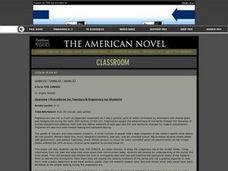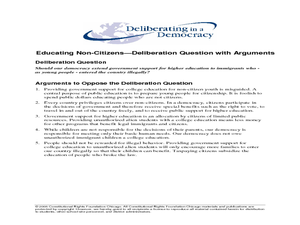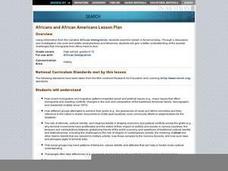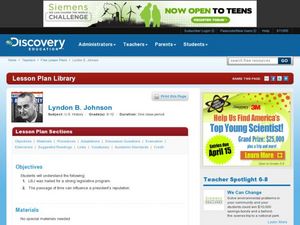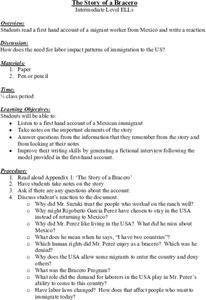School Improvement in Maryland
Immigration Legislation
What is the purpose of immigration legislation? How has this legislation evolved over the years? What are the factors that caused these changes? Class members research immigration legislation to determine whose rights the laws are...
Curated OER
Immigration Policy: Past and Present
Students examine the history of the United States' immigration policy. They identify events in history that changed policies regarding immigrants. They discuss new possible legislation as well.
Curated OER
Teaching Reading Comprehension through Social Studies Readings
Examine how immigrants have changed the environment of the United States. Individually, middle schoolers will take a pre- and post-test to assess their reading comprehension. In groups, they compare and contrast the religions of...
Curated OER
Paying With Their Health
Students consider the plight of immigrant workers. In this undocumented immigrant lesson, students compare the worker of the Industrialization era to the undocumented immigrant workers of today. Students read and discuss literature about...
NPR
Chinese American Women Lesson Plan
The National Women's History Museum provides a plan designed to accompany their online CyberExhibit, Chinese American Women; a History of Resilience and Resistance. After examining a series of primary and secondary source documents,...
Curated OER
Immigration in the United States from 1880-1910
Eleventh graders explore, examine and study immigration in the United States from 1880-1910. They identify different aspects of the American immigration movement. Each student also shares where their ancestors are from and their...
Bette Brooks
"No Irish Need Apply..."
Students describe conditions that led to massive immigration from Ireland in the 1840s, and compare response of native-born Americans to Irish immigration with responses to Mexican immigration today.
Curated OER
Government Lesson Plan: Lesson Plan 6
Students examine legislation on immigration policies. They discuss current immigration laws, read a handout, complete a chart, and answer discussion questions.
Curated OER
Life in THE JUNGLE
Students discuss problems immigrants may have when coming to a new country. They take on the role of a law maker from the era and create an action plan and policy based on samples they read (links provided). Students discuss ways their...
University of Wisconsin
Why Did the Triangle Fire Occur?
An investigation of the 1911 New York City Triangle Shirtwaist Factory fire leads class members to examine primary and secondary source materials related to the event and apply what they learn about the working conditions at the time to...
Deliberating in a Democracy
Educating Non-Citizens
Students distinguish between the privileges of being a U.S. Citizen and privileges that are forfeited if not a U.S. Citizen. For this history activity, students analyze the rights of people in a democratic society through research,...
Curated OER
The Kite Runner: Citizenship Test
Could you pass a citizenship test? As part of their study of Khaled Hosseini's The Kite Runner and the immigrant experience, class members are presented with a sample citizenship test.
Curated OER
Pioneering Principles: Why Character Matters
What does it mean to "be of good character"? What are the qualities that define such a person? The 1825 Colonization Law of Coahuila y Texas required that all new immigrants into Mexican Texas present documentation that they were of...
Curated OER
Whose Neighborhood is It? Whose America is This?
Pupils use electronic resources to study immigration issues, analyze immigration issues dealing with security, economics, lawfulness, culture, and human rights, and discuss possible solutions. Students then express their opinions by...
Curated OER
Editorial Cartoons: A Historical Example of Immigration Debates
Eleventh graders analyze political cartoons. In this American History instructional activity, 11th graders research the Chinese Exclusion Act and the current arguments about immigration to the United States. Students create a...
Curated OER
Sacco and Vanzetti: “The Case That Will Not Die”
Studying this case within its historical context can help us better understand urgent current issues of today.
Curated OER
Who Was Here?
Students explore how their community has also had various waves of immigration over the years. It asks students to visit a local cemetery and examine the names and dates on the headstones to find evidence of who lived in the community...
Curated OER
Africans and African Americans
Students complete small group tasks related to racism as it applies to African Americans, African immigrants, and white immigrants. Through discussion of their findings, students explain of challenges in society that African immigrants...
Curated OER
Do Suspected Enemies Have Rights?
Students investigate the history of Japanese immigration. They complete an online Webquest, explore various websites, answer discussion questions, and locate and read newspaper articles about enemy compatants.
Curated OER
Lyndon B. Johnson
Students take a closer look at legislation passed in the 1960s. In this Great Society lesson, students research 6 key pieces of legislation signed into law by Johnson. Students use their findings to write collaborative reports.
Curated OER
Child Labor in the Carolinas
Fifth graders explore child labor and how children were exploited and used in the work place. In this Industrial Revolution activity, 5th graders research child labor by reading, looking at photographs and drawing conclusions...
Curated OER
The Story of a Bracero
Learners study a first person account written by a migrant worker from Mexico. They write a reaction to it. They discuss immigration to the US and how it effects labor patterns.
Curated OER
People on the Move
Students explore transportation. In this transportation lesson, students examine the Jupiter locomotive, Washingtion D.C. streetcars, the Leviathan, the Salisbury Train Station, and Route 66. Students respond to 12 questions.
Curated OER
Bystanders in the Holocaust
Students recognize effects of apathy and indifference, examine behaviors associated with obedience, conformity, and silence, and explore legal responses to issues raised by the Holocaust.








